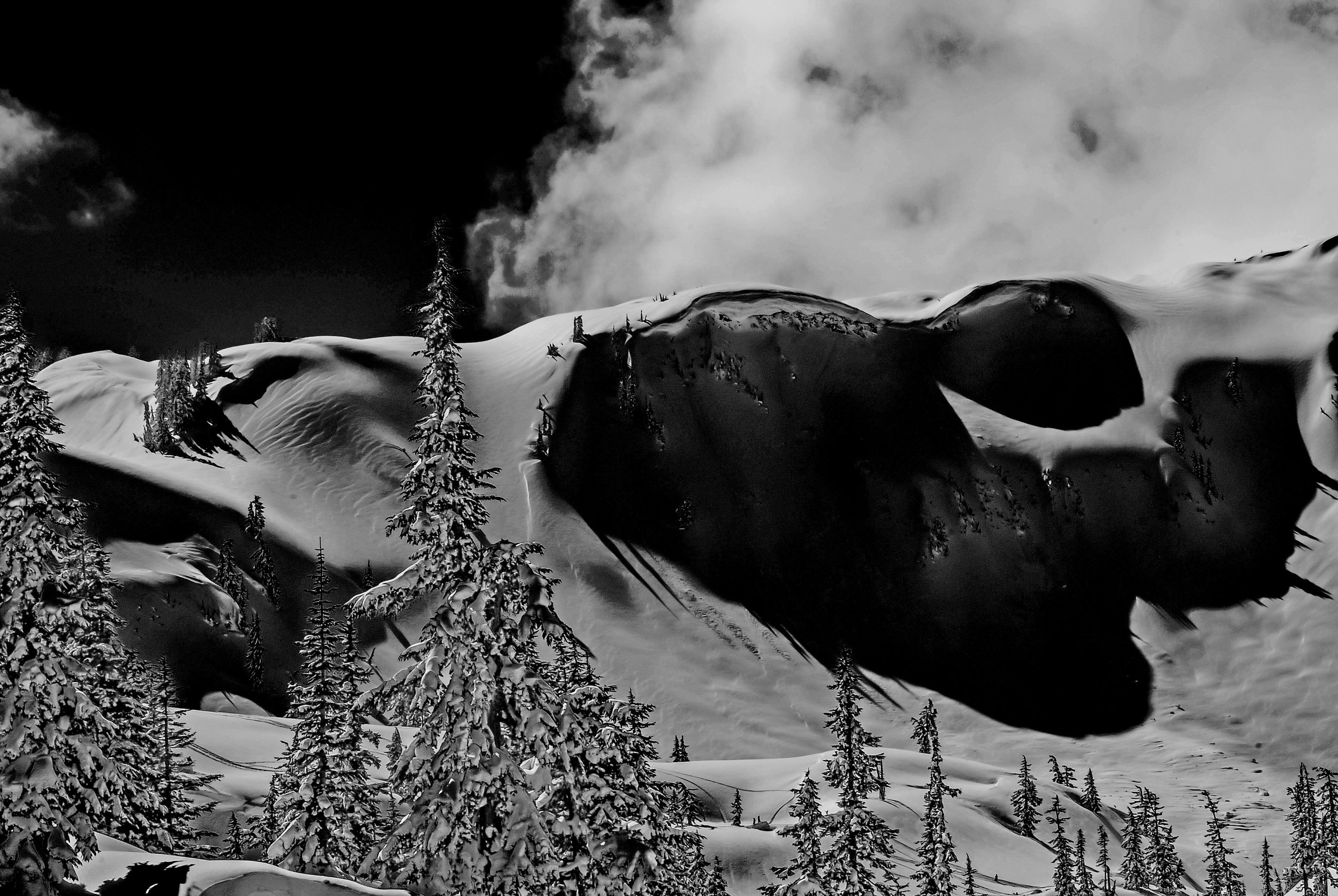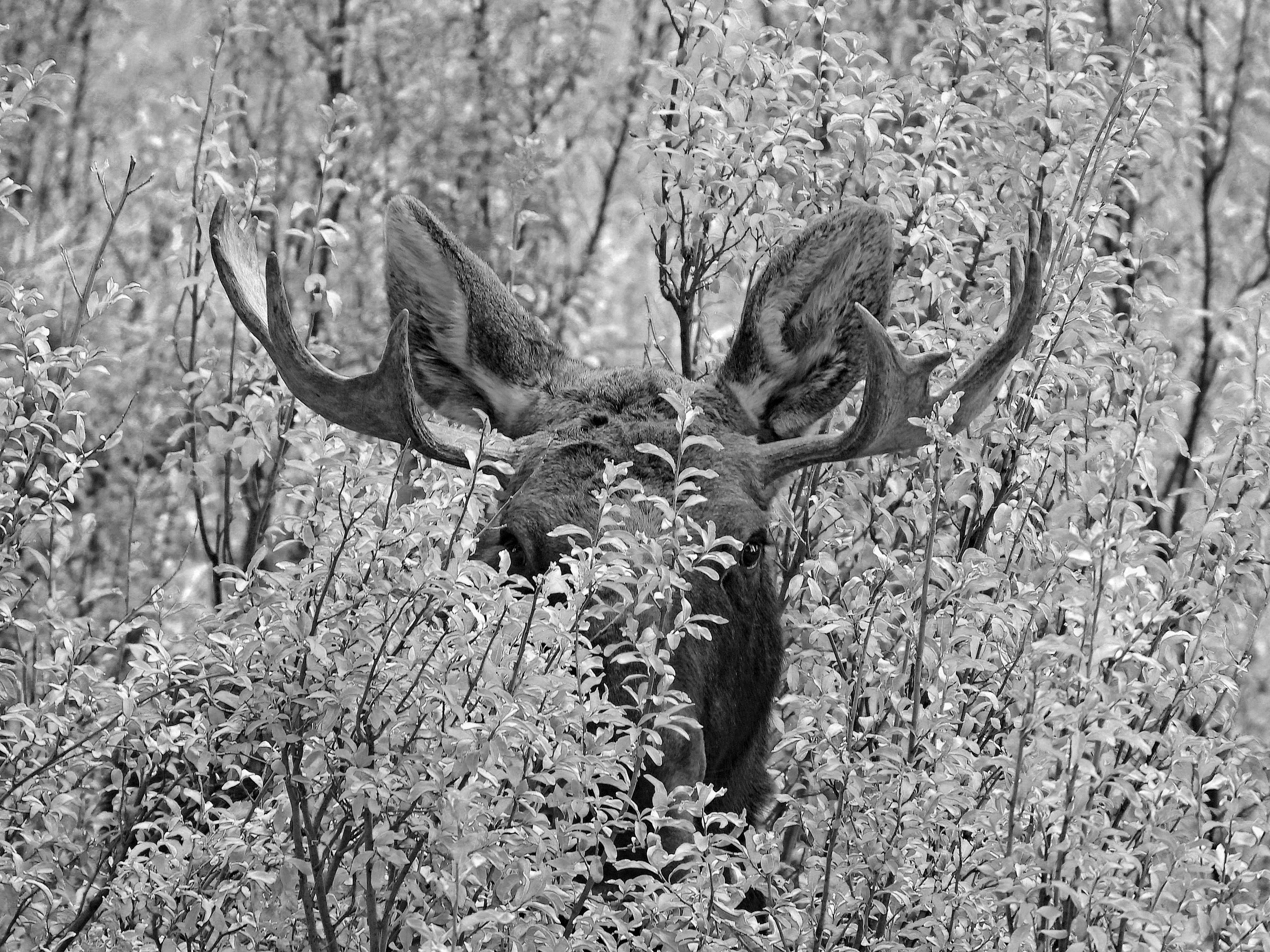Monochrome and Infrared
Black and White photography has been around for a long time. The first photographs taken, within the world of photography, were black and white. It can lead to very dramatic statements when it comes to the story you may be telling in your photographs. Let’s take a look at some examples of how monochrome can help create drama in your shots.
Infrared. I do love digital infrared photography. I’ll explain, as I go from shot to shot, how infrared effects primary colors. For instance, the sky on the upper left of the frame was a deep blue, blue and beautiful. Infrared will turn a blue, depending on how light or dark the shade, somewhere between a light gray, or closer to black. Since the sky was a deeper shade of blue, it turned closer to black, allowing the white clouds to really pop off of it, along with the white of the snow. I darkened the highlights and the shadows to give it an almost eerie glow to some of the more shadowy parts. I love the drama that infrared can provide to a photo.
You might see this in a representation of someone’s nightmare. Or in an eerie movie when a creepy, dead forest is depicted. Give me some wispy clouds, a deep blue sky and a tree that has gnarled branches and I’ll come back with a creepy shot to be sure!
Last creepy one, I promise. I don’t think I’ve ever made it a secret that I enjoy post-processing some of my images. This one was simple. Turn it infrared, and make the whole photo darker. There was a sun break which made the sun appear like a big ol’ spotlight. Trouble can brew in a photograph with the right amount of creativity and finesse from the initial perspective, right when you press the shutter release, to whatever post-processing you may do afterwards. Digitally infrared is really versatile and can lend as much, or as little, drama and creepiness that you require for your shots.
If you take the color green and turn it infrared, depending on the shade of green, it can turn a darker green a darker shade of gray and, conversely, a lighter shade of green will turn closer to white. That drastic change in color can give you and otherworldly or even, fairy tale type of composition. This bridge I shot in Scotland, with the thicker foliage on the trees and the river below, just screamed to be turned into infrared. The stone of the bridge really helps to age the photo as well.
Sometimes you want the main subject of your image to stand out. I took this shot, of a young bull moose, while in the Tetons in Wyoming. He was standing, dead center, in a thicket of shrubbery. The foliage was a medium to light green with the brown stems from which the leaves were growing. With the bull’s brown hair, he just kind of melded into everything around him. So, I turned the shot infrared and he kind of pops right off the white of the foliage, instead of blending into it. One of my faves for sure!
Another favorite shot is this one from Bellingham, Washington. I went to tour a farm, open to the public, and there were several gardens associated with it. There was a bunch of Dark-Eyed Susans that I shot from slightly underneath them. The petals were a bright, yellow-orange, made white after applying infrared. Apart from the speckling of clouds, the sky was nice shade of blue and you can see that the area around that sun is a mid to lighter gray, while getting darker the further from the sun you go. I closed my shutter all the way down to get the burst effect of the sun. It’s such a dramatic change from the color version yet, equally as compelling, if not more so.
I hope you enjoyed this little tutorial on Monochrome and Infrared photography. For those of you who are more into photography, than just a cell phone, monochrome can have dramatic effect on your thought, regardless if you use infrared or not, black and white can have stunning effect to the story you’re trying to tell. Nikon has point and shoot cameras that, not only do not break the bank but, have the capacity to have full manual capabilities. And digital, as I’ve stated in past blogs, is the greatest way to learn how to take a proper photo. Take a shot, if you don’t like it, place it in the trash (in the camera), recompute your settings and take it again. Easy and fun and the best way to learn, in my estimation, and before you know it you’re taking great photos. Adobe has a program, not part of the cloud, called Photoshop Elements. You pay a nominal fee, download it onto your computer and even you can turn your photos infrared. It’s what I use and I love it. One time purchase price and it’s yours forever. You can keep buying the new versions every year, if you choose, or just stick with the first version you purchase. I like the newer versions because they come with new processes you can apply to your photos. If you get one, drop me a line and let me know, I may be able to help navigate through some of it!
At any rate, that does it for me. The countdown is on for our, my wife’s and mine, next big adventure. More on that later. Go out and enjoy the visually wonderful places this rock has to offer. Be good to yourselves and each other, until the next time, be and travel well.






